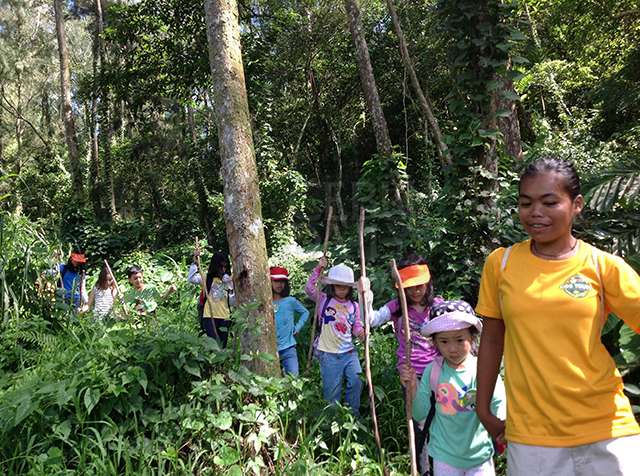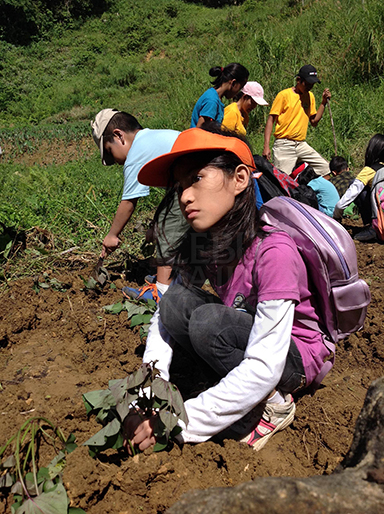A forest tour for the kids

A Mantalongon tour guide leads city kids in a trek through Mag-Alambak Forest in Dalaguete, which was the highlight of the I SEE KIDS Tour Forest Adventure for Courage. (CONTRIBUTED PHOTO/FRAULINE MARIA S. ABANGAN)
(First of two parts)
Trees towered above them as they passed through the thick foliage that sometimes bookended a narrow and slippery path. There was no Mockingjay and there were no Capitol soldiers chasing them, but that didn’t stop the older ones of the ten city kids from pretending they were in the Hunger Games.
(Hunger Games, composed of the best-selling trilogy Hunger Games, Catching Fire and Mockingjay written by American author Suzanne Collins, centers on a fictional nation named Panem dominated by the wealthy and technologically advanced Capitol ruling 12 poor districts. It follows the life of Katniss Everdeen, 16, who lives in Panem’s poorest district, as she takes part in “Hunger Games,” a televised show where participants from the poor districts are forced to fight to the death across vast mostly forested areas. The winner gets for his/her home district food, supplies, and riches.)
The ten children, aged 5-11, were participants in the launching of the “I See Kids Tours” (ISKT) in mid-December last year in Barangay Mantalongon, Cebu’s vegetable basket in the southern town of Dalaguete. The highlight of the tour was the two-hour trek through the 48-hectare Mag-Alambak Forest.
The kids’ trek was actually fairly short as the two hours included time spent on two rest stops — one for food and another for games.
Another I See Kids Tours took place at the Bojo River in Aloguinsan on Jan. 9 this year, joined by seven kids aged 5 to 9.
Inspired by the “I See Cebu” children’s book, the tour is the first of its kind in the Philippines where the focus is on the children, with the parents just tagging along.
The Mantalongon guides are farmers trained for about a year with the help of Ramon Aboitiz Foundation Inc. (RAFI), which sponsored ISKT’s community development work and training.
The ISKT guides in Bojo River are fishermen and farmers, who are also members of the Bojo Aloguinsan Ecotourism Association (Baetas), which won the 2015 Tourism InSPIRE Award for Best Community-based Tourism Initiative in Asia-Pacific.
Despite their experience, the Baetas staff still underwent the same special training that their Mantalongon counterparts did. They all worked with child development experts to learn how to properly interact with their young customers.

Seven-year old Raine Chiara plants kamote (sweet potato) in a farm in Mantalongon, Dalaguete along with nine other children, aged 5-11, who participated in the I SEE KIDS Tour launching on December 15, 2015. (CONTRIBUTED PHOTO/FRAULINE MARIA S. ABANGAN)
Baetas president Rudney Carcuevas said dealing with children was more challenging than interacting with adults. He said they were still adjusting particularly when it comes to communicating with kids who are used to speaking in English and sometimes cannot understand certain Cebuano words.
Carcuevas said they hoped to succeed in the kids tour just like they did in the adults tour.
The base of the Mantalongon ISKT is the Manguerra Summer Home, more known as The Staff House. In Aloguinsan, a large open nipa hut called the Play House was built with children in mind.
The Tour
As soon as they arrived at the sites, the kids received name badges and were welcomed with a folk song popular in the area. Food came next — a welcome sight after their long journey from the city.
With an early start of 8 a.m., the Mantalongon tour participants were served a breakfast of pancakes drizzled with honey and garnished with edible Malacopa flowers and basil leaves, scrambled eggs with tomatoes and onions, and sikwate (hot chocolate brewed from locally produced cocoa or tableya).
In Bojo, participants who came at 9 a.m. had a more traditional but equally delicious fare of budbud (sticky rice cake wrapped in banana leaves), puto (steamed rice buns), mango and sikwate.
Morning circle is the first activity where the kids introduced themselves and played games to encourage them to bond. Junior Ranger orientations emphasize on behavior expected from them during the trek or cruise. Parents had a separate briefing.
The Mantalongon morning circle was more physical while the Bojo morning circle was more on the arts and crafts side.
The kids who joined the Bojo tour were taught how to make a snake out of palm leaves and a boat out of banana leaves. The Bojo tour parents, particularly the mothers, also had their own fun learning to weave coasters and hanging rice containers from palm leaves.
Raymund Fernandez, his wife and three kids were among those who joined the Mantalongon tour. They joined because they wanted to experience something
different. At home, he said, they have Internet, there’s TV, and there are gadgets. “We want them (children) to have access to nature.”
Sherefel Rosalejos, who brought her six-year old daughter to the Bojo River tour, also wanted her child to be exposed to and appreciate the beauty of nature.
Sherefel said she herself also learned a lot from the tour, especially about the different types of mangroves. She was also impressed with the facilities at the Bojo River.
Mantalongon
Trailing after the Mantalongon tour guides, the kids learned about the makahiya plant, played with weeds, watched a horned goat do its business, and picked and ate wild strawberries and edible flowers.
The first rest stop was at a farm where the kids were taught how to plant and harvest kamote (sweet potato).
Some of the children were reluctant at first but after some coaxing and gentle encouragement from the ISKT staff, they eventually got down and dirty as well. They gleefully held up the kamote they uncovered.
After washing their hands carefully with soap and water, the children were treated to snacks of sweet potato fries and boiled kamote, washed down with cold kamote juice.
The parents who watched in the sidelines were full of praises for the activity.
“Nindot kaayo (This is very nice). It was never boring. It’s very educational,” Fernandez said.
She said never in their lives had his children experienced something like that, where they learned how the kamote was planted and harvested and then had a chance to enjoy it as cooked food.
Fernandez’s 11-year-old daughter Ravyn gushed over the experience of harvesting kamote. “I had one of the best days of my life,” she later posted on her social media account, as she shared her Mantalongon experience with her Facebook friends.
Six-year old Sem said hiking was fun and she liked listening to the birds chirping.
“My heart felt so big. I was so happy. It was my first time to feel like a real adventurer,” said Sem. Never mind that she didn’t understand why the older kids were talking about the Hunger Games during the trek. (to be concluded)
Disclaimer: The comments uploaded on this site do not necessarily represent or reflect the views of management and owner of Cebudailynews. We reserve the right to exclude comments that we deem to be inconsistent with our editorial standards.
